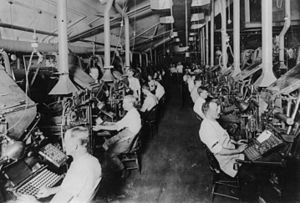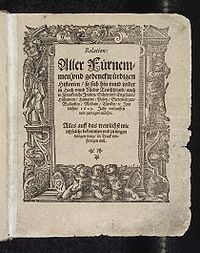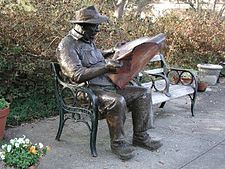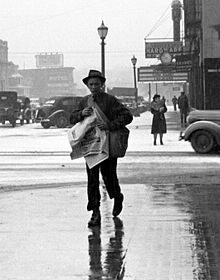- Newspaper
-
A newspaper is a scheduled publication containing news of current events, informative articles, diverse features and advertising. It usually is printed on relatively inexpensive, low-grade paper such as newsprint. By 2007, there were 6580 daily newspapers in the world selling 395 million copies a day. The worldwide recession of 2008, combined with the rapid growth of web-based alternatives, caused a serious decline in advertising and circulation, as many papers closed or sharply retrenched operations.[1]
General-interest newspapers typically publish stories on local and national political events and personalities, crime, business, entertainment, society and sports. Most traditional papers also feature an editorial page containing editorials written by an editor and columns that express the personal opinions of writers. The newspaper is typically funded by paid subscriptions and advertising.
A wide variety of material has been published in newspapers, including editorial opinions, criticism, persuasion and op-eds; obituaries; entertainment features such as crosswords, sudoku and horoscopes; weather news and forecasts; advice, food and other columns; reviews of radio, movies, television, plays and restaurants; classified ads; display ads, radio and television listings, inserts from local merchants, editorial cartoons, gag cartoons and comic strips.
Contents
Definition
Newspapers typically meet four criteria:[2][3]
- Publicity: Its contents are reasonably accessible to the public.
- Periodicity: It is published at regular intervals.
- Currency: Its information is up to date.
- Universality: It covers a range of topics.
History
Gazettes and bulletins
Before the invention of newspapers in the early 17th century, official government bulletins were circulated at times in some centralized empires.
In Ancient Rome, Acta Diurna, or government announcement bulletins, were produced. They were carved in metal or stone and posted in public places.
In China, early government-produced news sheets, called tipao, circulated among court officials during the late Han dynasty (second and third centuries AD). Between 713 and 734, the Kaiyuan Za Bao ("Bulletin of the Court") of the Chinese Tang Dynasty published government news; it was handwritten on silk and read by government officials. In 1582, there was the first reference to privately published newssheets in Beijing, during the late Ming Dynasty.[4]
In Early modern Europe the increased cross-border interaction created a rising need for information which was met by concise handwritten newssheets. In 1556, the government of Venice first published the monthly Notizie scritte, which cost one gazetta.[5] These avvisi were handwritten newsletters and used to convey political, military, and economic news quickly and efficiently to Italian cities (1500–1700) — sharing some characteristics of newspapers though usually not considered true newspapers.[6]
However, none of these publications fully met the classical criteria for proper newspapers, as they were typically not intended for the general public and restricted to a certain range of topics.
Newspapers
Main article: History of newspapers and magazinesSee also: List of the earliest newspapersEurope
See also: History of British newspapersThe emergence of the new media branch in the 17th century has to be seen in close connection with the spread of the printing press from which the publishing press derives its name.[7]
The German-language Relation aller Fürnemmen und gedenckwürdigen Historien, printed from 1605 onwards by Johann Carolus in Strasbourg, is often recognized as the first newspaper.[8][9] At the time, Strasbourg was a free imperial city in the Holy Roman Empire of the German Nation; the first newspaper of modern Germany was the Avisa, published in 1609 in Wolfenbüttel.
Other early papers include:
The Dutch Courante uyt Italien, Duytslandt, &c. ('Courant from Italy, Germany, etc.') of 1618 was the first to appear in folio- rather than quarto-size. Amsterdam, a center of world trade, quickly became home to newspapers in many languages, often before they were published in their own country.[10]
The first English-language newspaper, Corrant out of Italy, Germany, etc., was published in Amsterdam in 1620. A year and a half later, Corante, or weekely newes from Italy, Germany, Hungary, Poland, Bohemia, France and the Low Countreys. was published in England by an "N.B." (generally thought to be either Nathaniel Butter or Nicholas Bourne) and Thomas Archer.[11]
The first newspaper in France was published in 1631, La Gazette (originally published as Gazette de France).[5]
The first newspaper in Portugal, Gazeta, was published in 1641 in Lisbon.[12] The first Spanish newspaper, Gaceta de Madrid, was published in 1661.
Post- och Inrikes Tidningar (founded as Ordinari Post Tijdender) was first published in Sweden in 1645, and is the oldest newspaper still in existence, though it now publishes solely online.[13]
Opregte Haarlemsche Courant from Haarlem, first published in 1656, is the oldest paper still printed. It was forced to merge with the newspaper Haarlems Dagblad in 1942 when Germany occupied the Netherlands. Since then the Haarlems Dagblad has appeared with the subtitle Oprechte Haerlemse Courant 1656. It considers itself to be the oldest newspaper still in print.
Merkuriusz Polski Ordynaryjny was published in Kraków, Poland in 1661.
The first successful English daily, The Daily Courant, was published from 1702 to 1735.[10][14]
Americas
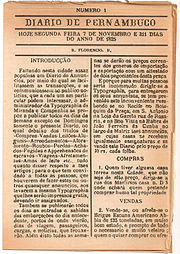 Diario de Pernambuco, founded in 1825 is the first newspaper in South America.
Diario de Pernambuco, founded in 1825 is the first newspaper in South America. See also: History of American newspapers
See also: History of American newspapersIn Boston in 1690, Benjamin Harris published Publick Occurrences Both Forreign and Domestick. This is considered the first newspaper in the American colonies even though only one edition was published before the paper was suppressed by the government. In 1704, the governor allowed The Boston News-Letter to be published and it became the first continuously published newspaper in the colonies. Soon after, weekly papers began publishing in New York and Philadelphia. These early newspapers followed the British format and were usually four pages long. They mostly carried news from Britain and content depended on the editor’s interests. In 1783, the Pennsylvania Evening Post became the first American daily.
In 1752, John Bushell published the Halifax Gazette, the first Canadian newspaper.
The first newspaper in South America was Diario de Pernambuco, established in 1825.
By 2007, there were 1,456 daily newspapers in the U.S., selling 55 million copies a day.[15]
Asia
See also: Print media in IndiaSee also: Japanese newspapersSee also: History of Chinese newspapersMiddle East
See also: History of Middle Eastern newspapersIndustrial Revolution
By the early 19th century, many cities in Europe, as well as North and South America, published newspaper-type publications though not all of them developed in the same way; content was vastly shaped by regional and cultural preferences.[16] Advances in printing technology related to the Industrial Revolution enabled newspapers to become an even more widely circulated means of communication. In 1814, The Times (London) acquired a printing press capable of making 1,100 impressions per minute.[17]
Soon, it was adapted to print on both sides of a page at once. This innovation made newspapers cheaper and thus available to a larger part of the population. In 1830, the first penny press newspaper came to the market: Lynde M. Walter's Boston Transcript.[18] Penny press papers cost about one sixth the price of other newspapers and appealed to a wider audience.[19] In France, Émile de Girardin started "La Presse" in 1836, introducing cheap, advertising-supported dailies to France. In 1848, August Zang, an Austrian who knew Girardin in Paris, returned to Vienna to introduce the same methods with "Die Presse" (which was named for and frankly copied Girardin's publication).[20]
Categories
While most newspapers are aimed at a broad spectrum of readers, usually geographically defined, some focus on groups of readers defined more by their interests than their location: for example, there are daily and weekly business newspapers and sports newspapers. More specialist still are some weekly newspapers, usually free and distributed within limited areas; these may serve communities as specific as certain immigrant populations, or the local gay community.
Daily
A daily newspaper is issued every day, sometimes with the exception of Sundays and occasionally Saturdays,[21] and often of some national holidays. Saturday and, where they exist, Sunday editions of daily newspapers tend to be larger, include more specialized sections and advertising inserts, and cost more. Typically, the majority of these newspapers’ staff work Monday to Friday, so the Sunday and Monday editions largely depend on content done in advance or content that is syndicated. Most daily newspapers are published in the morning. Afternoon or evening papers are aimed more at commuters and office workers.
UK
In the UK, unlike most other countries, most "daily" newspapers do not publish on Sundays; in many cases the same publisher produces a Sunday newspaper, distinct in many ways from the daily, usually with a related name; e.g. The Times and The Sunday Times are distinct newspapers owned by the same company, and an article published in the latter would never be credited to The Times.
Weekly
Main article: Weekly newspaperWeekly newspapers are published once a week, and tend to be smaller than daily papers. Some newspapers are published two or three times a week; in the United States, such newspapers are generally called weeklies[citation needed].
National
Most nations have at least one newspaper that circulates throughout the whole country: a national newspaper, as contrasted with a local newspaper serving a city or region. Some national newspapers, such as The Financial Times and The Wall Street Journal, are specialised (in these examples, on financial matters). There are many national newspapers in the UK, but only few in the United States and Canada. In the United States, in addition to national newspapers as such, The New York Times is available throughout the country[citation needed].
Almost every market has one or two newspapers that dominate the area. Large metropolitan newspapers often have large distribution networks, and can be found outside their normal area, sometimes widely, sometimes from fewer sources.
International
There is also a small group of newspapers which may be characterized as international newspapers. Some, such as The International Herald Tribune, have always had that focus, while others are repackaged national newspapers or "international editions" of national or large metropolitan newspapers. In some cases articles that might not interest the wider range of readers are omitted from international editions; in others, of interest to expatriates, significant national news is retained.
As English became the international language of business and technology, many newspapers formerly published only in non-English languages have also developed English-language editions. In places as varied as Jerusalem and Mumbai, newspapers are printed for a local and international English-speaking public, and for tourists. The advent of the Internet has also allowed non-English-language newspapers to put out a scaled-down English version to give their newspaper a global outreach.
Similarly, in many countries with a large foreign-language-speaking population or many tourists, newspapers in languages other than the national language are both published locally and imported. For example, newspapers and magazines from many countries, and locally-published newspapers in many languages, are readily to be found on news-stands in central London.
Online
Main article: Online newspaperVirtually all printed newspapers have online editions, which depending on the country may be regulated by journalism organizations such as the Press Complaints Commission in the UK.[22] But as some publishers find their print-based models increasingly unsustainable, Web-based "newspapers" have also started to appear, such as the Southport Reporter in the UK and the Seattle Post-Intelligencer,[23] which stopped publishing in print after 149 years in March 2009 and went online only.
Customized
A new trend in newspaper publishing is the introduction of individualization through on-demand printing technologies. Customized newspapers allow the reader to create their individual newspaper through the selection of individual pages from multiple publications. This "Best of" approach allows to revive the print-based model and opens up a new distribution channel to increase coverage beneath the usual boundaries of distribution. Customized newspapers online have been offered by MyYahoo, I-Google, CRAYON, ICurrent.com, Kibboko.com, Twitter.times and many others.
Organization and personnel
In the United States, the overall manager or chief executive of the newspaper is the publisher.[24] In small newspapers, the owner of the publication (or the largest shareholder in the corporation that owns the publication) is usually the publisher. Although he or she rarely or perhaps never writes stories, the publisher is legally responsible for the contents of the entire newspaper and also runs the business, including hiring editors, reporters, and other staff members. This title is less common outside the U.S. The equivalent position in the film industry and television news shows is the executive producer.[citation needed]
Most newspapers have four main departments devoted to publishing the newspaper itself—editorial, production/printing, circulation, and advertising, although they are frequently referred to by a variety of other names—as well as the non-newspaper-specific departments also found in other businesses of comparable size, such as accounting, marketing, human resources, and IT.
Throughout the English-speaking world, the person who selects the content for the newspaper is usually referred to as the editor. Variations on this title such as editor-in-chief, executive editor, and so on are common. For small newspapers, a single editor may be responsible for all content areas. At large newspapers, the most senior editor is in overall charge of the publication, while less senior editors may each focus on one subject area, such as local news or sports. These divisions are called news bureaus or "desks", and each is supervised by a designated editor. Most newspaper editors copy edit the stories for their part of the newspaper, but they may share their workload with proofreaders and fact checkers.
Reporters are journalists who primarily report facts that they have gathered and those who write longer, less news-oriented articles may be called feature writers. Photographers and graphic artists provide images and illustrations to support articles. Journalists often specialize in a subject area, called a beat, such as sports, religion, or science. Columnists are journalists who write regular articles recounting their personal opinions and experiences.
Printers and press operators physically print the newspaper. Printing is outsourced by many newspapers, partly because of the cost of an offset web press (the most common kind of press used to print newspapers) and also because a small newspaper's print run might require less than an hour of operation, meaning that if the newspaper had its own press it would sit idle most of the time. If the newspaper offers information online, webmasters and web designers may be employed to upload stories to the newspaper's website.
The staff of the circulation department liaise with retailers who sell the newspaper; sell subscriptions; and supervise distribution of the printed newspapers through the mail, by newspaper carriers, at retailers, and through vending machines. Free newspapers do not sell subscriptions, but they still have a circulation department responsible for distributing the newspapers.
Sales staff in the advertising department not only sell space to clients such as local businesses, but also help advertisers design and plan their advertising campaigns. Other members of the advertising department may include graphic designers, who design ads according to the customers' specifications and the department's policies. In an advertising-free newspaper, there is no advertising department.
Zoned and other editions
Newspapers often refine distribution of ads and news through zoning and editioning. Zoning occurs when advertising and editorial content change to reflect the location to which the product is delivered. The editorial content often may change merely to reflect changes in advertising — the quantity and layout of which affects the space available for editorial — or may contain region-specific news. In rare instances, the advertising may not change from one zone to another, but there will be different region-specific editorial content. As the content can vary widely, zoned editions are often produced in parallel.
Editioning occurs in the main sections as news is updated throughout the night. The advertising is usually the same in each edition (with the exception of zoned regionals, in which it is often the ‘B’ section of local news that undergoes advertising changes). As each edition represents the latest news available for the next press run, these editions are produced linearly, with one completed edition being copied and updated for the next edition. The previous edition is always copied to maintain a Newspaper of Record and to fall back on if a quick correction is needed for the press. For example, both The New York Times and The Wall Street Journal offer a regional edition, printed through a local contractor, and featuring locale specific content. The Journal's global advertising rate card provides a good example of editioning.[25]
Format
Most modern newspapers are in one of three sizes:
- Broadsheets: 600 mm by 380 mm (23½ by 15 inches), generally associated with more intellectual newspapers, although a trend towards "compact" newspapers is changing this.
- Tabloids: half the size of broadsheets at 380 mm by 300 mm (15 by 11¾ inches), and often perceived as sensationalist in contrast to broadsheets. Examples include The Sun, The National Enquirer, The Star Magazine, New York Post, the Chicago Sun-Times, The Globe.
- "Microdaily" is infrequently used to refer to a tabloid-sized free daily newspaper that offers lower ad rates than its broadsheet competitors. The content of a microdaily can range from intense local news coverage to a combination of local and national stories.
- Berliner or Midi: 470 mm by 315 mm (18½ by 12¼ inches) used by European papers such as Le Monde in France, La Stampa in Italy, El Pais in Spain and, since 2005, The Guardian in the United Kingdom.
Newspapers are usually printed on cheap, off-white paper known as newsprint. Since the 1980s, the newspaper industry has largely moved away from lower-quality letterpress printing to higher-quality, four-color process, offset printing. In addition, desktop computers, word processing software, graphics software, digital cameras and digital prepress and typesetting technologies have revolutionized the newspaper production process. These technologies have enabled newspapers to publish color photographs and graphics, as well as innovative layouts and better design.
To help their titles stand out on newsstands, some newspapers are printed on coloured newsprint. For example, the Financial Times is printed on a distinctive salmon pink paper, and Sheffield's weekly sports publication derives its name, the Green ’Un, from the traditional colour of its paper. The Italian sports newspaper La Gazzetta dello Sport is also printed on pink paper while L'Équipe (formerly L’Auto) is printed on yellow paper. Both the latter promoted major cycling races and their newsprint colours were reflected in the colours of the jerseys used to denote the race leader; for example the leader in the Giro d'Italia wears a pink jersey.
Circulation and readership
Main articles: List of newspapers in the World by circulation and Newspaper circulationThe number of copies distributed, either on an average day or on particular days (typically Sunday), is called the newspaper’s circulation and is one of the principal factors used to set advertising rates. Circulation is not necessarily the same as copies sold, since some copies or newspapers are distributed without cost. Readership figures may be higher than circulation figures because many copies are read by more than one person, although this is offset by the number of copies distributed but not read (especially for those distributed free).
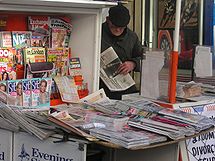 Newspaper vendor, Paddington, London, February 2005
Newspaper vendor, Paddington, London, February 2005
According to the Guinness Book of Records, the daily circulation of the Soviet newspaper Trud exceeded 21,500,000 in 1990, while the Soviet weekly Argumenty i Fakty boasted the circulation of 33,500,000 in 1991.
According to United Nations data from 1995 Japan has three daily papers —the Yomiuri Shimbun, Asahi Shimbun, and Mainichi Shimbun — with circulations well above 5.5 million. Germany's Bild, with a circulation of 3.8 million, was the only other paper in that category. In the United Kingdom, The Sun is the top seller, with around 3.24 million copies distributed daily.
In the U.S., The Wall Street Journal has a daily circulation of approximately 2.02 million, making it the most widely distributed paper in the country.[26]
While paid readership of print newspapers has been steadily declining in the developed OECD nations, it has been rising in the chief developing nations (Brazil, India, Indonesia, China and South Africa), whose paid daily circulation exceeded those of the developed nations for the first time in 2008.[27] In India, The Times of India is the largest-circulation English newspaper, with 3.14 million copies daily. According to the 2009 Indian Readership Survey, the Dainik Jagran is the most-read, local-language (Hindi) newspaper, with 55.7 million readers.[28] According to Tom Standage of The Economist, India currently has daily newspaper circulation of 110 million copies.[29]
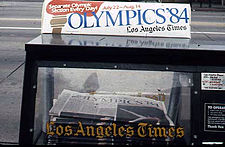 American newspaper vending machine.
American newspaper vending machine.
A common measure of a newspaper’s health is market penetration, expressed as a percentage of households that receive a copy of the newspaper against the total number of households in the paper’s market area. In the 1920s, on a national basis in the U.S., daily newspapers achieved market penetration of 123 percent (meaning the average U.S. household received 1.23 newspapers). As other media began to compete with newspapers, and as printing became easier and less expensive giving rise to a greater diversity of publications, market penetration began to decline. It wasn’t until the early 1970s, however, that market penetration dipped below 100 percent. By 2000, it was 53 percent.[30]
Many paid-for newspapers offer a variety of subscription plans. For example, someone might want only a Sunday paper, or perhaps only Sunday and Saturday, or maybe only a workweek subscription, or perhaps a daily subscription.
Most newspapers provide some or all of their content on the Internet, either at no cost or for a fee. In some cases, free access is available only for a matter of days or weeks, or for a certain number of viewed articles, after which readers must register and provide personal data. In other cases, free archives are provided.
Journalism News · Writing style
Ethics · Objectivity
Values · Attribution
Defamation
Editorial independence
Journalism school
Areas Arts · Business
Entertainment
Environment
Fashion · Medicine
Politics · Science
Sports · Technology
Trade · Traffic
Weather · WorldGenres Advocacy · Analytic · Broadcast
Citizen · Civic
Collaborative · Community
Database · Gonzo
Investigative · Literary
Muckraking · Narrative
"New Journalism"
Non-profit journalism
Online · Opinion
Peace · Photojournalism
Scientific · Visual · WatchdogSocial impact Fourth Estate
Freedom of the press
Infotainment · Media bias
Public relations
Press service
Yellow journalismNews media Newspapers · Magazines
TV and radio
Internet
News agencies
Alternative mediaRoles Journalist · Reporter
Editor · Columnist
Copy editor
Meteorologist
News presenter
Photographer
Pundit/Political commentatorCategory: Journalism Advertising
A newspaper typically generates 70–80% of its revenue from advertising, and the remainder from sales and subscriptions.[31] The portion of the newspaper that is not advertising is called editorial content, editorial matter, or simply editorial, although the last term is also used to refer specifically to those articles in which the newspaper and its guest writers express their opinions. (This distinction, however, developed over time – early publishers like Girardin (France) and Zang (Austria) did not always distinguish paid items from editorial content.)
The business model of having advertising subsidize the cost of printing and distributing newspapers (and, it is always hoped, the making of a profit) rather than having subscribers cover the full cost was first done, it seems, in 1833 by The Sun, a daily paper that was published in New York City. Rather than charging 6 cents per copy, the price of a typical New York daily at the time, they charged 1 cent, and depended on advertising to make up the difference.[32]
Newspapers in countries with easy access to the web have been hurt by the decline of many traditional advertisers. Department stores and supermarkets could be relied upon in the past to buy pages of newspaper advertisements, but due to industry consolidation are much less likely to do so now.[33] Additionally, newspapers are seeing traditional advertisers shift to new media platforms. The classified category is shifting to sites including Craigslist, employment websites, and auto sites. National advertisers are shifting to many types of digital content including websites, rich media platforms, and mobile.
In recent years, the advertorial emerged. Advertorials are most commonly recognized as an opposite-editorial which third-parties pay a fee to have included in the paper. Advertorials commonly advertise new products or techniques, such as a new design for golf equipment, a new form of laser surgery, or weight-loss drugs. The tone is usually closer to that of a press release than of an objective news story.
Journalism
Main article: JournalismSince newspapers began as a journal (record of current events), the profession involved in the making of newspapers began to be called journalism.
In the yellow journalism era of the 19th century, many newspapers in the United States relied on sensational stories that were meant to anger or excite the public, rather than to inform. The restrained style of reporting that relies on fact checking and accuracy regained popularity around World War II.
Criticism of journalism is varied and sometimes vehement. Credibility is questioned because of anonymous sources; errors in facts, spelling, and grammar; real or perceived bias; and scandals involving plagiarism and fabrication.
In the past, newspapers have often been owned by so-called press barons, and were used for gaining a political voice. After 1920 most major newspapers became parts of chains run by large media corporations such as Gannett, The McClatchy Company, Hearst Corporation, Cox Enterprises, Landmark Media Enterprises LLC, Morris Corporation, The Tribune Company, Hollinger International, News Corporation, Swift Communications, etc.
Newspapers have, in the modern world, played an important role in the exercise of freedom of expression. Whistle-blowers, and those who "leak" stories of corruption in political circles often choose to inform newspapers before other mediums of communication, relying on the perceived willingness of newspaper editors to expose the secrets and lies of those who would rather cover them. However, there have been many circumstances of the political autonomy of newspapers being curtailed.
Opinions of other writers and readers are expressed in the op-ed ("opposite the editorial page") and letters to the editors sections of the paper.
Some ways newspapers have tried to improve their credibility are: appointing ombudsmen, developing ethics policies and training, using more stringent corrections policies, communicating their processes and rationale with readers, and asking sources to review articles after publication.
Impact of television and Internet
Main article: Future of newspapersFurther information: Online NewspapersBy the late 1990s, the availability of news via 24-hour television channels and then the Internet posed an ongoing challenge to the business model of most newspapers in developed countries. Paid circulation has declined, while advertising revenue — which makes up the bulk of most newspapers’ income — has been shifting from print to the new media, resulting in a general decline in profits. Many newspapers around the world launched online editions in an attempt to follow or stay ahead of their audience.
However, in the rest of the world, cheaper printing and distribution, increased literacy, the growing middle class and other factors have more than compensated for the emergence of electronic media and newspapers continue to grow.[34]
On April 10, 1995, The American Reporter[35] became the first daily newspaper, with its own paid reporters around the world and all-original content, to start on the Internet. The editor-in-chief and founder is Joe Shea. The site is owned by 400 journalists.[36]
The future of newspapers in countries with easy internet access has been widely debated as the industry has faced down soaring newsprint prices, slumping ad sales, the loss of much classified advertising and precipitous drops in circulation. In recent years the number of newspapers slated for closure, bankruptcy or severe cutbacks has risen—especially in the United States, where the industry has shed a fifth of its journalists since 2001.[37] Revenue has plunged while competition from internet media has squeezed older print publishers.[37]
The debate has become more urgent lately, as a deepening recession has shaved profits,[38] and as once-explosive growth in newspaper web revenues has leveled off, forestalling what the industry hoped would become an important source of revenue.[39] At issue is whether the newspaper industry faces a cyclical trough, or whether new technology has rendered obsolete newspapers in their traditional format.
Reading newspaper print has a lower impact on global warming than reading online, according to one of the world's leading paper-makers, because the impact of powering computers allegedly outweighs the impact of creating newsprint. "Reading a newspaper has a lower impact on global warming than reading the news online for 30 minutes," according to Torraspapel's Paper.[40]
See also
- List of newspaper comic strips
- Lists of newspapers
Footnotes
- ^ Plambeck, Joseph (April 26, 2010). "Newspaper Circulation Falls Nearly 9%". The New York Times. http://www.nytimes.com/2010/04/27/business/media/27audit.html?scp=3&sq=newspapers&st=Search. Retrieved October 26, 2011.
- ^ Werner Faulstich: "Grundwissen Medien", 4th ed., UTB, 2000, ISBN 978-3-8252-8169-4, chapter 4
- ^ Margarete Rehm: Information und Kommunikation in Geschichte und Gegenwart. Das 17. Jh.
- ^ Brook, Timothy. (1998). The Confusions of Pleasure: Commerce and Culture in Ming China. Berkeley: University of California Press. ISBN 0-520-22154-0 (Paperback). Page xxi.
- ^ a b Wan-Press.org, A Newspaper Timeline, World Association of Newspapers
- ^ Infelise, Mario. "Roman Avvisi: Information and Politics in the Seventeenth Century." Court and Politics in Papal Rome, 1492–1700. Cambridge: Cambridge University Press, 2002. 212,214,216–217
- ^ Weber, Johannes (2006), "Strassburg, 1605: The Origins of the Newspaper in Europe", German History 24 (3): 387–412 (387):
At the same time, then, as the printing press in the physical, technological sense was invented, 'the press' in the extended sense of the word also entered the historical stage. The phenomenon of publishing was born.
- ^ "Weber, Johannes: Straßburg 1605: Die Geburt der Zeitung, in: Jahrbuch für Kommunikationsgeschichte, Vol. 7 (2005), S. 3–27" (in German). http://www.uni-leipzig.de/%7Ehsk/pgs/jahrbuch/2005/Weber_Strassburg1605.pdf.
- ^ World Association of Newspapers: "Newspapers: 400 Years Young!"
- ^ a b Stephens, Mitchell, NYU.edu, "History of Newspapers", Collier's Encyclopedia
- ^ BL.uk, Concise History of the British Newspaper in the Seventeenth Century
- ^ [1], GAZETA, em qve se relatam as novas todas, qve ovve nesta corte, e qve vieran de varias partes no mes de nouembro de 1641 - Com todas as licenças neceßárias. E priuilegio real. Em Lisboa. Na officina de Lourenço de Anueres.
- ^ Oldest newspapers still in circulation, World Association of Newspapers
- ^ Concise History of the British Newspaper in the Eighteenth Century
- ^ See A Daily Miracle: A student guide to journalism and the newspaper business (2007)
- ^ Newspaper – Britannica Online Encyclopedia
- ^ Philip B. Meggs, A History of Graphic Design (1998) pp 130–133
- ^ David R. Spencer, The Yellow Journalism (2007) p. 22.
- ^ Bird, S. Elizabeth. For Enquiring Minds: A Cultural Study of Supermarket Tabloids. Knoxville: University of Tennessee Press, 1992: 12–17.
- ^ Wurzbach, C. (1891). Biographisches Lexikon des Kaiserthums Oesterreich, enthaltend die Lebensskizzen der denkwürdigen Personen, welche seit 1750 in den österreichischen Kronländern geboren wurden oder darin gelebt und gewirkt haben, (162–165); Jim Chevallier, "August Zang and the French Croissant: How Viennoiserie Came to France", p. 3-30; Diepresse.com Article in "Die Presse" on its founding.
- ^ Example of Monday to Friday-only publishing: the London Evening Standard, once a paid newspaper, now free-of-charge, aimed largely at commuters, does not publish on Saturdays
- ^ Journalism Magazine
- ^ SeattlePI.com
- ^ Bureau of Labor Statistics (17 December 2009). "Career Guide to Industries, 2010–11 Edition: Publishing, Except Software". U.S. Department of Labor. http://www.bls.gov/oco/cg/cgs013.htm. Retrieved 28 May 2010.
- ^ "WSJ Advertising: Rates". Advertising.wsj.com. http://advertising.wsj.com/rates/index.html. Retrieved 2008-10-10.
- ^ Liedtke, Michael (October 26, 2009). "Newspaper circulation drop accelerates April-Sept". The Seattle Times. http://seattletimes.nwsource.com/html/businesstechnology/2010138873_apusnewspapercirculation.html. Retrieved October 26, 2011.
- ^ OECD Working Party on the Information Economy (11 June 2010). "THE EVOLUTION OF NEWS AND THE INTERNET". http://www.oecd.org/dataoecd/30/24/45559596.pdf. Retrieved 14 July 2011."Growth in the BIICS countries by about 35% from 2000 to 2008 very much contributed to this growth, most notably India with a 45% increase in circulation between 2000 and 2008, South Africa (34%) and China (an estimated 29%). Gains are not only occurring there but also in other countries and continents, including Africa and South America." p.24
- ^ Dailies add 12.6 million readers – NRS Chennai, 2009 August 29[dead link] (Web.Archive.org)
- ^ Standage, Tom (2011-7-13). The Kojo Nnamdi Show. Interview with Kojo Nnamdi. WAMU. Washington, DC. See also Print media in India#Readership
- ^ Newspapers: Audience – State of the Mews Media 2004[dead link](Web.Archive.org)
- ^ Mensing, Donica (Spring 2007). "Online Revenue Business Model Has Changed Little Since 1996". Newspaper Research Journal. http://findarticles.com/p/articles/mi_qa3677/is_200704/ai_n25137495/.
- ^ "Reinventing the newspaper". The Economist. July 7, 2011. http://www.economist.com/node/18904178. Retrieved July 13, 2011.
- ^ The Newspaper Sector Faces A Dangerous Decline of Advertiser Demand – by James A. Maccaro (Wall Street Cosmos Industry Report: Newspaper Publishing)
- ^ N. Ram, Newspaper futures: India and the world, August 15, 2007, The Hindu
- ^ American-reporter.com
- ^ J.D. Lasica, "Net Gain," American Journalism Review, Vol. 18, November 1996
- ^ a b Saba, Jennifer (March 16, 2009). "Specifics on Newspapers from 'State of News Media' Report". Editor & Publisher. http://www.editorandpublisher.com/eandp/news/article_display.jsp?vnu_content_id=1003951616. Retrieved 2009-03-17.
- ^ Newspapers' ad revenue for 2008 fell 23%, according to the Newspaper Association of America. EditorAndPublischer.com
- ^ Clifford, Stephanie (October 12, 2008). "Newspapers' Web Revenue is Stalling". The New York Times. http://www.nytimes.com/2008/10/13/business/media/13adco.html?src=linkedin. Retrieved April 10, 2010.
- ^ Abbott, Jez (July 13, 2010). "Reading the printed page is 'greener' than online browsing, says papermaker". PrintWeek. http://www.printweek.com/paper/news/1015841/Reading-printed-page-greener-online-browsing-says-papermaker/. Retrieved October 26, 2011.
Further reading
- Willings Press Guide (134th ed. 3 vol. 2010), comprehensive guide to world press. Vol 1 UK, Vol 2 Europe and Vol 3 World. ISBN 1-906035-17-2
- Editor and Publisher International Year Book (90th ed. 2009), comprehensive guide to American newspapers
- Conley, David, and Stephen Lamble. The Daily Miracle: An Introduction to Journalism (3rd ed. 2006), 518pp; global viewpoint
- Harrower, Tim. The Newspaper Designer's Handbook (6th ed. 2007) excerpt and text search
- Jones, Alex. Losing the News: The Future of the News That Feeds Democracy (2009)
- Sousa, Jorge Pedro Sousa (Coord.); Maria do Carmo Castelo Branco; Mário Pinto; Sandra Tuna; Gabriel Silva; Eduardo Zilles Borba; Mônica Delicato; Carlos Duarte; Nair Silva; Patrícia Teixeira. A Gazeta “da Restauração”: Primeiro Periódico Português. Uma análise do discurso VOL. II - Reproduções (2011) ISBN 978-989-654-061-6 [2]
- Walravens, Hartmut, ed. Newspapers in Central And Eastern Europe (2004) 251pp
- Williams, Kevin. Read All About It!: A History of the British Newspaper (2009) excerpt and text search
External links
General
- Newspapers from List of Newspapers - Online Newspapers Directory
Newspaper archives
Categories:- Ephemera
- Newspapers
- Newspaper publishing
- Paper products
- Periodicals
- Media formats
- Printing
- Journalism
Wikimedia Foundation. 2010.


